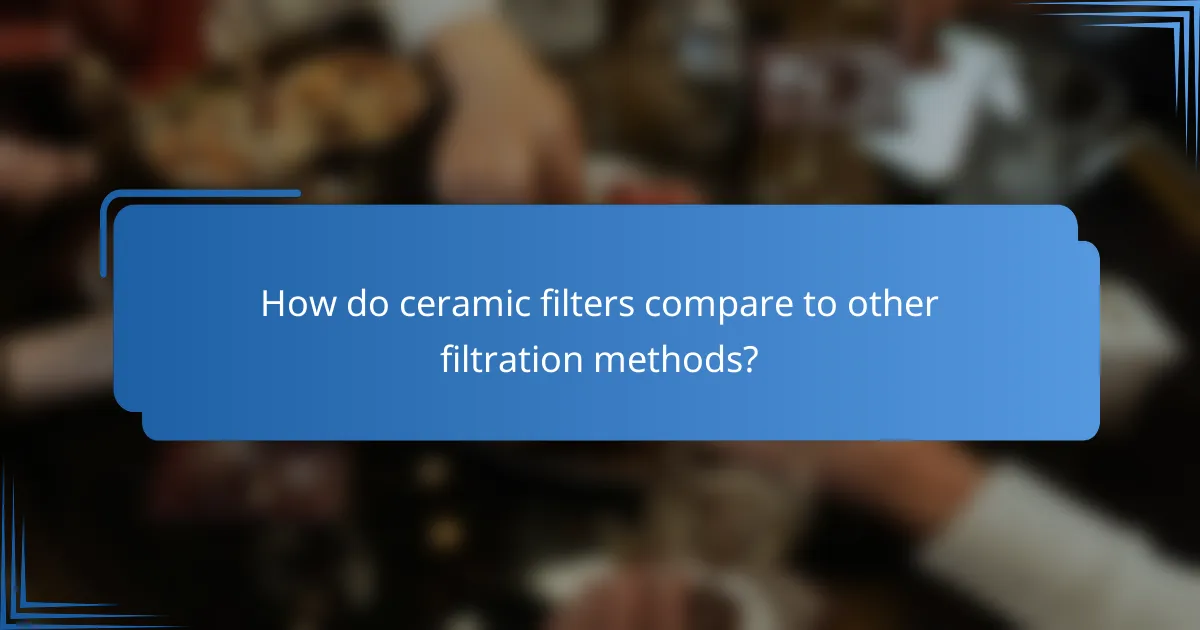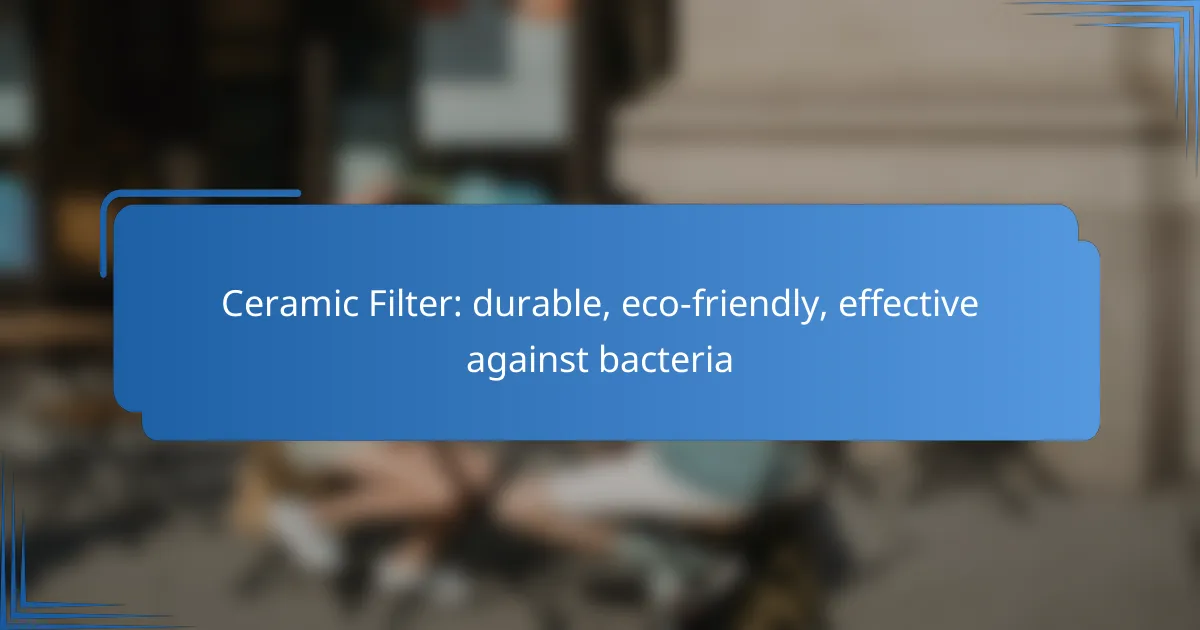Ceramic filters are an excellent choice for water purification, combining durability and eco-friendliness with effective bacteria removal. Their unique porous structure traps contaminants while allowing water to flow, and the addition of activated carbon enhances their filtration capabilities. Ideal for long-lasting performance, these filters are a sustainable solution for clean drinking water.

How do ceramic filters effectively remove bacteria?
Ceramic filters effectively remove bacteria through their unique porous structure, which physically traps contaminants while allowing water to flow. This filtration process is enhanced by the addition of activated carbon, which further improves the filter’s ability to purify water.
Porous structure traps bacteria
The porous nature of ceramic filters creates tiny openings that can capture bacteria and other pathogens as water passes through. These pores are typically small enough to block microorganisms, ensuring that the water remains safe for consumption.
For optimal performance, the pore size in ceramic filters usually ranges from 0.2 to 0.5 microns, effectively filtering out most harmful bacteria. Regular maintenance and cleaning of the filter can help maintain its efficiency over time.
Activated carbon enhances filtration
Activated carbon is often integrated into ceramic filters to improve their overall effectiveness. This material adsorbs organic compounds and chlorine, which can affect the taste and odor of water, while also assisting in the removal of some bacteria.
The combination of ceramic and activated carbon filtration can significantly enhance water quality, making it more palatable and safer for drinking. Users should replace the activated carbon periodically to ensure continued effectiveness.
Proven efficacy in laboratory tests
Laboratory tests have consistently shown that ceramic filters can reduce bacterial contamination by a high percentage, often exceeding 99%. These results demonstrate the reliability of ceramic filters in providing clean drinking water.
Many ceramic filters meet international standards for water purification, such as those set by the World Health Organization (WHO). This makes them a trusted choice for households looking to improve their water quality sustainably and effectively.

What are the benefits of using ceramic filters?
Ceramic filters offer several advantages, including durability, eco-friendliness, and effective bacteria removal. These filters are designed to provide long-lasting performance while being safe for the environment.
Durability and long lifespan
Ceramic filters are known for their robust construction, which allows them to withstand significant wear and tear. Typically, they can last several years with proper care, making them a cost-effective choice for water filtration.
Unlike plastic or paper filters, ceramic filters do not degrade easily and can maintain their effectiveness over time. Regular cleaning can extend their lifespan even further, ensuring consistent performance.
Eco-friendly materials
Made from natural materials, ceramic filters are an environmentally friendly option for water purification. They do not contain harmful chemicals or plastics, reducing the overall environmental impact.
By choosing ceramic filters, consumers contribute to sustainability efforts, as these filters are often biodegradable and can be disposed of without harming the planet. This makes them a responsible choice for eco-conscious individuals.
Low maintenance requirements
Ceramic filters require minimal maintenance, which is a significant advantage for users. Regular rinsing and occasional scrubbing are usually sufficient to keep the filter clean and functional.
Unlike other filtration systems that may need frequent replacements or complex upkeep, ceramic filters can be easily maintained at home. This simplicity makes them accessible for a wide range of users, from households to outdoor enthusiasts.

Where can you buy ceramic filters in the US?
Ceramic filters can be purchased from various sources in the US, including online platforms, specialty stores, and local home improvement centers. Each option offers different brands, price ranges, and product features, making it essential to compare before buying.
Online retailers like Amazon
Online retailers such as Amazon provide a wide selection of ceramic filters, often with customer reviews and competitive pricing. You can find filters from various brands, typically ranging from $20 to $100, depending on the size and filtration capabilities.
When shopping online, pay attention to product specifications, including the filter’s lifespan and the contaminants it effectively removes. Look for filters that meet NSF/ANSI standards for added assurance of quality.
Specialty water filtration stores
Specialty water filtration stores offer expert advice and a curated selection of ceramic filters. These stores often carry high-quality brands and can provide insights into which filter best suits your specific needs.
Prices at specialty stores may be higher than online options, typically starting around $30 and going up based on features. Consider visiting these stores for personalized recommendations and to see the products in person.
Local home improvement centers
Local home improvement centers like Home Depot or Lowe’s usually stock ceramic filters in their plumbing or water treatment sections. These stores provide a convenient option for those who prefer to shop in person.
Prices at home improvement centers generally range from $25 to $80. Check for any ongoing promotions or discounts, and don’t hesitate to ask staff for assistance in selecting the right filter for your household needs.

What factors should you consider when choosing a ceramic filter?
When selecting a ceramic filter, consider its filtration capacity, compatibility with your existing systems, and the brand’s reputation. These factors will ensure that you choose a filter that effectively meets your water purification needs while being durable and eco-friendly.
Filtration capacity and flow rate
The filtration capacity of a ceramic filter indicates how much water it can purify over a specific period. Look for filters that can handle your daily water consumption, typically ranging from a few liters to several dozen liters per hour, depending on your household size.
Flow rate is equally important, as it determines how quickly you can access filtered water. A higher flow rate means less waiting time, which is crucial for larger families or frequent use. Aim for filters that provide a balance between effective filtration and adequate flow rate.
Size and compatibility with existing systems
Ensure that the ceramic filter you choose fits well with your current water system. Measure the available space and check the filter’s dimensions to avoid installation issues. Filters come in various sizes, from compact units for small kitchens to larger systems for whole-house filtration.
Compatibility with existing plumbing is another key consideration. Some filters may require additional fittings or modifications to your plumbing, while others are designed for easy installation. Always check the manufacturer’s specifications to ensure a seamless integration.
Brand reputation and reviews
Researching brand reputation is essential when choosing a ceramic filter. Look for established brands known for their quality and reliability. Customer reviews can provide insight into the filter’s performance and durability, helping you make an informed decision.
Consider filters that have received certifications from recognized organizations, as these can indicate compliance with safety and quality standards. Reading user feedback can also highlight potential issues or advantages that may not be immediately apparent from product descriptions.

How do ceramic filters compare to other filtration methods?
Ceramic filters are effective, durable, and eco-friendly, making them a strong choice compared to other filtration methods. They excel in removing bacteria and sediments while requiring minimal maintenance and no chemicals.
Versus activated carbon filters
Ceramic filters and activated carbon filters serve different purposes. While activated carbon is excellent for removing chlorine, odors, and some chemicals, ceramic filters focus on filtering out bacteria and larger particles. This makes ceramic filters more suitable for ensuring microbiological safety in water.
In practical terms, ceramic filters can last several years with proper care, while activated carbon filters typically need replacement every few months. For households concerned about bacterial contamination, ceramic filters may be the preferred option.
Versus reverse osmosis systems
Reverse osmosis (RO) systems are highly effective in removing a wide range of contaminants, including heavy metals and dissolved solids. However, they can be more expensive and waste more water compared to ceramic filters. Ceramic filters, on the other hand, are simpler and do not require electricity to operate.
For those prioritizing cost-effectiveness and ease of use, ceramic filters can be a better choice, especially in areas where water quality is primarily a concern regarding bacteria rather than chemical pollutants.
Versus UV purification
UV purification systems are effective at killing bacteria and viruses but do not remove sediments or chemicals from water. In contrast, ceramic filters physically block contaminants while also providing some level of disinfection through their porous structure.
For comprehensive water treatment, combining a ceramic filter with UV purification can enhance safety, but for those looking for a standalone solution, ceramic filters offer a reliable and low-maintenance option.
